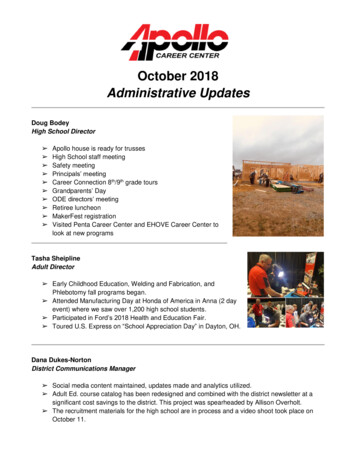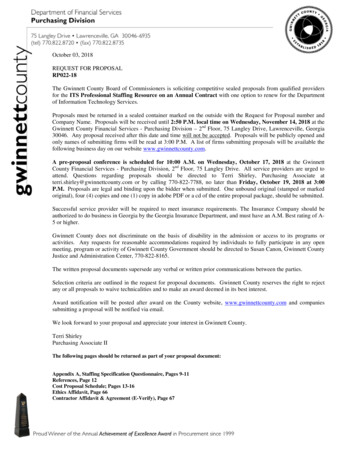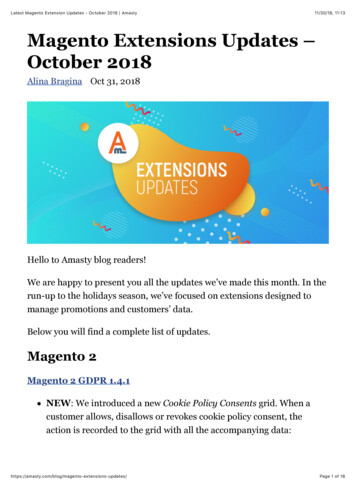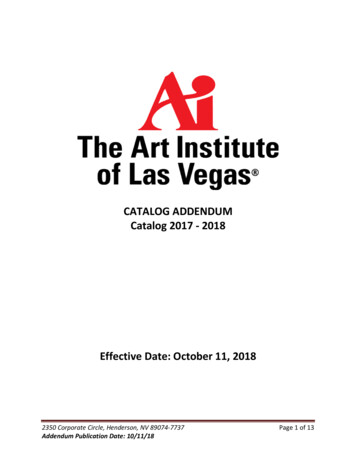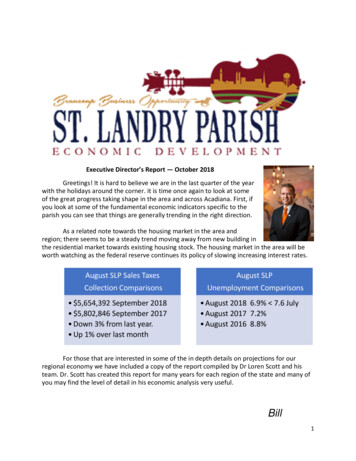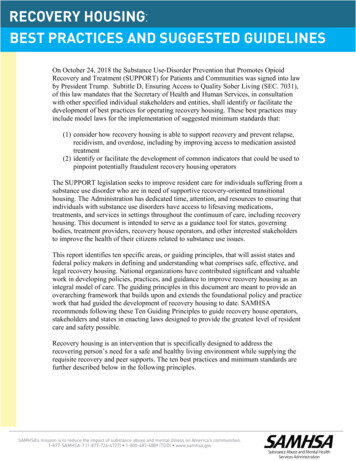
Transcription
On October 24, 2018 the Substance Use-Disorder Prevention that Promotes OpioidRecovery and Treatment (SUPPORT) for Patients and Communities was signed into lawby President Trump. Subtitle D, Ensuring Access to Quality Sober Living (SEC. 7031),of this law mandates that the Secretary of Health and Human Services, in consultationwith other specified individual stakeholders and entities, shall identify or facilitate thedevelopment of best practices for operating recovery housing. These best practices mayinclude model laws for the implementation of suggested minimum standards that:(1) consider how recovery housing is able to support recovery and prevent relapse,recidivism, and overdose, including by improving access to medication assistedtreatment(2) identify or facilitate the development of common indicators that could be used topinpoint potentially fraudulent recovery housing operatorsThe SUPPORT legislation seeks to improve resident care for individuals suffering from asubstance use disorder who are in need of supportive recovery-oriented transitionalhousing. The Administration has dedicated time, attention, and resources to ensuring thatindividuals with substance use disorders have access to lifesaving medications,treatments, and services in settings throughout the continuum of care, including recoveryhousing. This document is intended to serve as a guidance tool for states, governingbodies, treatment providers, recovery house operators, and other interested stakeholdersto improve the health of their citizens related to substance use issues.This report identifies ten specific areas, or guiding principles, that will assist states andfederal policy makers in defining and understanding what comprises safe, effective, andlegal recovery housing. National organizations have contributed significant and valuablework in developing policies, practices, and guidance to improve recovery housing as anintegral model of care. The guiding principles in this document are meant to provide anoverarching framework that builds upon and extends the foundational policy and practicework that had guided the development of recovery housing to date. SAMHSArecommends following these Ten Guiding Principles to guide recovery house operators,stakeholders and states in enacting laws designed to provide the greatest level of residentcare and safety possible.Recovery housing is an intervention that is specifically designed to address therecovering person’s need for a safe and healthy living environment while supplying therequisite recovery and peer supports. The ten best practices and minimum standards arefurther described below in the following principles.1
Ten Guiding Principles1. Have a clear operational definitionAll recovery housing should have a clear operational definition that accurately delineatesthe type of services offered and to what degree or intensity these services are provided.The SUPPORT legislation defined the term ‘recovery housing’ to describe a shared livingenvironment free from alcohol and illicit drug use and centered upon peer supports andconnection to services that promote sustained recovery from substance use disorders.Additionally, the Substance Abuse and Mental Health Services Administration(SAMHSA) official definition of recovery housing is described below:Recovery houses are safe, healthy, family-like substance-free living environmentsthat support individuals in recovery from addiction. While recovery residencesvary widely in structure, all are centered on peer support and a connection toservices that promote long-term recovery. Recovery housing benefits individualsin recovery by reinforcing a substance-free lifestyle and providing directconnections to other peers in recovery, mutual support groups and recoverysupport services. Substance-free does not prohibit prescribed medications takenas directed by a licensed prescriber, such as pharmacotherapies specificallyapproved by the Food and Drug Administration (FDA) for treatment of opioid usedisorder as well as other medications with FDA-approved indications for thetreatment of co-occurring disorders.For purposes of this document, SAMHSA’s official definition will serve as thebenchmark from which to ascribe best practices and suggested minimum standards. Theutilization of this definition is because it encompasses the basic tenets as set forth in thestatute and it stipulates the inclusion of FDA approved pharmacological interventions forsubstance use disorders and other co-occurring conditions.To deliver the best care possible, recovery house operators should include to which levelof care their facility delivers services to their residents. SAMHSA supports the levels ofcare, as identified by the National Alliance of Recovery Residences (NARR) and otherstakeholder agencies depicted below, as these levels accurately reflect the basic structuralblueprint of quality recovery housing and highlights the continuum of support rangingfrom nonclinical recovery housing to clinical and usually licensed treatment andhighlights the continuum of support ranging from nonclinical recovery housing (Level 1and II) to clinical and usually licensed treatment (Level III & IV).2
Source: The National Alliance for Recovery Residences2.Recognize that a substance use disorder is a chronic condition requiring a rangeof recovery supports:The transition from active addiction into lasting recovery is often a difficult andemotionally trying journey for many people with a substance-use disorder. NIDA (2018)indicated that the relapse rates for substance-use disorders is approximately 40-60%, andthat relapses could signify the necessity to reexamine a person’s course of treatment, asrelapses can be very dangerous and in many instances deadly. The first 12 months of thistransitional period prior to the onset of sustained full remission, sometimes referred to asearly recovery, is a crucial period during which people contend with raw core clinicalissues such as family history, unresolved trauma, grief and loss, emotional immaturity,low frustration tolerance, and other factors that make them susceptible to relapse.However, Moos & Moos (2006) determined that individuals with more ‘social capital’are more likely to show improved outcomes for short term remission. Therefore, recoveryhouses are uniquely qualified to assist individuals in all phases of recovery, especiallythose in early recovery, by furnishing social capital and recovery supports.Communities support is a critical aspect of achieving and maintaining recovery. Asupport network comprising friends and family who are not abusing substances, peerswith lived experience, trained recovery housing staff, clinical support, and access tocommunity resources is essential to helping people maintain recovery. Community,camaraderie, empathy and guidance are necessary ingredients in helping somebody3
remain on track as they navigate their way into a healthy lifestyle of recovery. This is truefor individuals recently discharged from inpatient treatment, criminal justice custody, orpeople seeking a safe, drug free living environment conducive to recovery.3.Recognize that co-occurring mental disorders often accompany substance-usedisorders:SAMHSA recommends that all recovery house operators and their designated staffshould be informed about co-occurring disorders and the close association these ailmentshave with substance-use disorders. The 2018 National Survey on Drug Use and Health(NSDUH) produced by SAMHSA determined that 9.2 million adults live with a cooccurring mental and substance use disorder. The NSDUH also demonstrates that thosewith mental disorders, including serious mental illness, are more likely to engage insubstance use; conversely, those with substance use disorders are also more likely to havea mental illness.It is critical that recovery house operators, staff, and certified peers need to be informedas to how co-occurring disorders and resulting symptomology can contribute to increase aperson’s susceptibility for relapse. Furthermore, SAMHSA believes that all residents andstaff should be instructed to treat each other with compassion and understandingregardless of mental health status.4.Assess applicant (potential resident) needs and the appropriateness of theresidence to meet these needs:SAMHSA recommends that all resident referrals and placement decisions be predicatedupon what gives the resident the best chance for obtaining lasting recovery. To help guideplacement decisions, SAMHSA strongly encourages all clinically oriented recoveryhouse programs to accurately assess each prospective resident according to their uniqueneeds, strengths, challenges and current recovery capital. SAMHSA maintains that properresident placement where an individual’s needs and goals are appropriately matched tothe facility including therapeutic services, recovery supports and the surroundingenvironment will help to ensure resident safety. To best achieve these ends, theassessment should include the prospective residence and important information about theperson.Resident assessment is an integral part of the comprehensive assessment that should beperformed prior to referral and placement into a recovery house system of care. Whetherthe referent is a licensed clinician, concerned family member, criminal justiceprofessional, or other stakeholder it is important to know and consider the relevant andpertinent information about a person before making impactful decisions regarding theirchances for a successful recovery. Usually a licensed clinician obtains intimateknowledge of the resident throughout the therapeutic process.State governing agencies, including law enforcement, are often important referral sourcesto recovery housing, it is necessary for these entities to be well versed about the4
prospective program prior to referring a potential resident. Relevant information to beconsidered in determining the most appropriate setting includes: 5.House Culture: such as permissiveness of unhealthy behaviors, degree ofadherence to outside meeting attendance, general living environment includingother peer’s investment in recovery, etc.Level of Care: the type, nature and intensity of therapeutic services and recoverysupports provided, ability to address specific needs.Utilization of certified or appropriately trained peers with relevant livedexperienceGeographic area, neighborhood or external surrounding environment of therecovery housePhysical living environmentCurrent residents: welcoming, committed to sobriety, are they mostly employed,supportive of one anotherMedication Assisted Treatment: does the operator or other house staff support theuse of medication assisted treatment, is the use of this medication properlymonitored, are the other residents in the house also supportive of MAT, are peerswith MAT experience available for residents with severe opioid use disorder(OUD)Level of training and professionalism of house staff (e.g., co-occurring disorder,crisis interventions, etc.)Reputation regarding ethical business practices, including fraud and abuse ofresidentsRelapse policyAvailability of opioid-overdose reversal drugsPromote and use evidence-based practices:Given the critical importance of stable housing and community supports to attainingrecovery, it is important to ensure that residents in recovery housing are afforded highquality, evidence-based care. It is important to recognize that many in recovery housingwill also need access to outpatient treatment. Polcin (2009) found significantimprovements in abstinence and employment rates, as well as a reduction in the numberof arrest rates for those residents who also participated in outpatient treatment forsubstance use disorder(s). Additionally, 76% of the residents that participated in thisstudy remained domiciled in a recovery house for at least five months. For many, thecombination of recovery housing with evidenced-based outpatient treatment is anefficacious model of care.Medication Assisted Treatment (MAT) is a lifesaving evidence-based practice. MATincludes the use of FDA-approved medications for the treatment of opioid use disorders.Medication therapy in conjunction with counseling, behavioral therapies, and communityrecovery supports provide a whole-individual approach to the treatment of substance-usedisorders. The National Academies of Science, Engineering, and Medicine (NASEM)5
notes that medications for opioid use disorders save lives and cite the use of thesemedications as an integral strategy in addressing opioid misuse.Peers and recovery coaches are other essential components that model the societal andfellowship aspects of recovery, and are fully endorsed by SAMHSA as integralcomponents of recovery houses. Peer Support Recovery Services (PRSS) and recoverycoaches have emerged as an efficacious intervention to help utilize lived experience toassist others in achieving and maintaining recovery. (Smelson et al, 2013; Tracey et al,2011).6. Written policies, procedures, and resident expectationsRecovery house operators should have clearly written and easy to read documentation forall standard operating procedures and policies. To avoid ambiguity, SAMHSArecommends that the standard operating procedures are clearly explained to each newresident by a house staff member or designated senior peer. It is also advisable forprograms to establish a resident handbook to help ease transition and ensure compliancewith house rules.Each resident should sign the documents to verify comprehension; residents should begiven a copy for future reference. The house should store the signed documents. Thecommunication of these procedures should also be accompanied by an orientationprocess.7. Ensures quality, integrity and resident safety:SAMHSA is strongly recommending that all recovery houses adhere to ethical principlesthat place resident safety as the chief priority. SAMHSA believes that unethical practicesmust be acted upon very quickly. One emerging unethical issue is patient brokering.Patient brokering is a potentially life threatening form of healthcare /treatment fraud thatinvolves using vulnerable people with a substance use disorder as a pawn or commodityto be traded.In patient-brokering type practices, a broker or agent refers a person, who is either inactive use or has relapsed after treatment, to an unethical treatment center for a financialfee or some other valuable kickback. In many instances, the brokered individual, who isalready in sobriety after completing treatment, is enticed through financial inducementsand/or free drugs to resume use by the brokering agent, who then refers this person backto treatment for a kickback. The unethical treatment center is then able to bill a thirdparty payer for services rendered, which far exceed the kickback paid making thisfraudulent business very lucrative. In other brokering type scenarios, people with anactive substance use disorder are lured by inducements such as free travel, rent or drugsfrom around the country to seek treatment in another state or location. Once theseindividuals arrive at treatment they are then recruited to engage in the brokering process.6
Recovery house operators should be well aware of the existence of these types ofpractices and should understand that these are unacceptable and unethical practices.Program CertificationProgram or recovery house certification or accreditation is one noted remedy to some ofthe problems stated above. States are advised to adopt a process of certification to assureprogram quality.In July 2017 the city of Delray Beach Florida required certification for allrecovery residences housing 4 or more unrelated individuals. A year laterafter this rule was implemented the city of Delray Beach witnessed asignificant 60% decline in overdoses from 635 to 245. The city of DelrayBeach also saw another 48% decrease in overdoses for the most recentyear since this ordinance became law.In regards to the Fair Housing Act, it should be noted that in Bangarter v. Orem CityCorp (1995) the court stated that the Fair Housing Amendments Act should not beviewed to preclude special restrictions on disabled or vulnerable people if the benefit ofsuch restrictions for these populations clearly outweighs the burden of these restrictions.Therefore, certification of recovery residences should not be prohibited as adiscriminatory practice if the certification is narrowly tailored to benefit the needs ofvulnerable populations, and these benefits clearly outweigh whatever burdens areimposed by these rules.It is standard clinical protocol for all treatment centers and recovery houses to requireclients submit to random urine analyses and breathalyzers. In other situations clients orresidents may be required to submit an additional sample if they are suspected of using orafter returning to the treatment center after time spent in a potentially using type ofenvironment. This protocol is designed to ensure safety by confirming people are sober,on track in their recovery and not in need of additional therapeutic interventions. FairHealth examined claims data based on Current Procedural Terminology (CPT) codes anddetermined that costs associated with laboratory testing have increased more than 900percent between 2011 and 2014. This large increase is an indication that a standardclinical practice has been exploited for financial gain. SAMHSA panelists identified 3key areas of concern for this unethical practice: Testing for quantitative amounts on negative samples Charging exorbitant fees over and above the standard costs for lab tests Excessive drug screenings during residential treatments (testing can also becomeexcessive in some outpatient treatments)7
Medication Policy:According the NSDUH (2018) buprenorphine was the opioid with the highest rate ofmisuse by those with a prescription for it. The misuse of any medication in a sober livingenvironment can have detrimental effects not just for the individual misusing but also forother members of the house. As such, the following strategies are recommended: Locking medication up and house staff providing medication at specified time toclients Medication counts with staff and resident Increase drug testing (if suspected of diversion) Communication between stakeholders, providers & staff (releases of information) Maintain proper documentation Monitor specific residents as needed Open discussion of medications (e.g., group topic, potential triggers, etc.) Daily dosing within a licensed facility8. Learn and Practice Cultural Competence:The concept of cultural competency is of extreme importance, as the disease of addictiondoes not discriminate along racial, cultural or socioeconomic lines.The staff and peers who operate and work in recovery houses should treat all individualswith respect regardless of their personal backgrounds and beliefs. Staff should be trainedto deal with individuals on a personal basis and respect different beliefs and backgrounds.9. Maintain ongoing communication with interested parties and care specialistsOngoing communication is another important aspect of clinical practice that recoveryhouses should implement as part of their operating procedures. Provided there is a signedrelease of confidential information, ongoing communication between the resident’sreferent, concerned loved one, treatment provider, former treatment provider, certifiedpeer recovery coach and criminal justice professional, is essential to helping the residentstay on track with recovery. In certain vocational programs, it could also be advantageousto maintain contact with the person’s place of employment. Listed below are some topicsareas that could be covered during communication between stakeholders to improve thequality of resident care. Level of program adherenceResident behavior – potential relapse indictorsAttendance concerns at treatmentMAT dosage changes, take home d
assist others in achieving and maintaining recovery. (Smelson et al, 2013; Tracey et al, 2011). 6. Written policies, procedures, and resident expectations . Recovery house operators should have clearly written and easy to read documentation for all standard operating procedures



